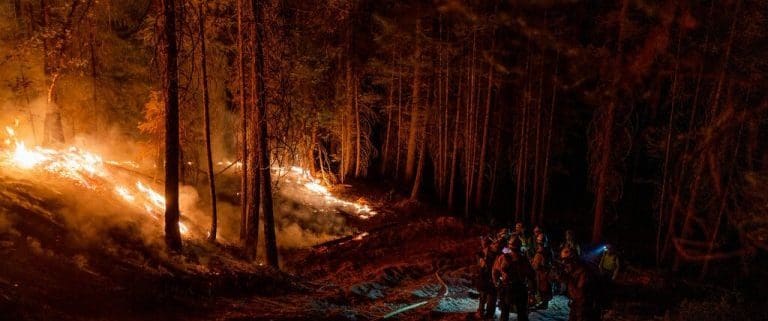Over 90 large fires across seven states are triggering alerts over poor air
Dangerous blazes continue to spread across the West, with 93 large fires burning in seven states.
As smoke plumes rise into the skies, alerts for hazardous air quality are in effect in parts of Oregon, Washington state, Idaho, Wyoming and Montana. A special weather statement about hazardous air quality was also issued in east-central California and western Nevada. The smoke is most dense and toxic near its source but has also expanded in lesser amounts all the way to the East Coast.
Idaho — where the Moose Fire, the nation’s second largest, is burning — leads the pack in terms of large fires, according to the National Interagency Fire Center (NIFC).
Firefighters are battling 34 large fires in the state, followed by 23 in Montana, 13 in Washington, 12 in California and nine in Oregon. Utah and Wyoming each report one large fire.
In Oregon, eyes are on the Cedar Creek Fire, which has grown to more than 86,000 acres after being sparked by lightning Aug. 1. After days of extreme fire growth, the fire remains uncontained. The rapidly spreading blaze has forced nearly 1,500 evacuations, while blanketing nearby cities such as Bend in dangerously high levels of smoke. Smoke from the fire has prompted alerts in south-central Oregon.
Firefighters are also battling the massive Double Creek Fire in Oregon, which has burned more than 155,000 acres and is currently the nation’s largest blaze. That inferno has prompted the Oregon Department of Environmental Quality to issue an air quality advisory for the northeastern parts of the state.
Fire and heavy smoke conditions in the West are unlikely to abate anytime soon, as hot and dry conditions have left forests ripe for fire growth. Red-flag warnings have been hoisted for much of eastern Wyoming because of hot, dry conditions conducive to fires.
Hazardous air quality conditions — air quality index (AQI) levels of 301-plus — have been observed in at least five states, including California, where the Mosquito Fire continues to burn between Sacramento and Reno, Nev., in the Sierra Nevada.
The Mosquito Fire has forced officials to evacuate more than 11,000 people. At least 25 homes have already been destroyed by the blaze, which has torched more than 48,700 acres and is just 16 percent contained.
Other active and dangerous fires in California include the Fairview Fire, which still burns close to the town of Hemet, though it is now 56 percent contained. Downpours from the remnants of Tropical Storm Kay have assisted crews in containing that blaze. That fire has burned more than 28,000 acres and killed two people who were trying to flee the blaze.
As more fires in the West are ignited and active fires expand, the smoke can travel as far as the East Coast and in the past has even blown into continental Europe. Wildfire smoke has been found to be surprisingly harmful to people even far from the source. A study published in 2021 found that three-quarters of smoke-related cases of asthma visits to emergency departments and deaths occurred east of the Rocky Mountains.
“Smoke is not just a Western problem,” said Katelyn O’Dell, lead author of the study and postdoctoral research scientist at George Washington University.
O’Dell suggested there may be a “lack of awareness” in the East about the effects of smoke, “because you’re not in proximity to these large wildfires, and they don’t really impact your day-to-day.”
The National Oceanic and Atmospheric Administration described an “expansive area of light smoke” covering most of the Lower 48 state, except for the far southeast and far southwest on Monday. However, computer simulations indicate much of the smoke in the eastern United States is at relatively high altitudes, meaning it shouldn’t substantially compromise air quality near the ground. But NOAA reported some “moderate to thick smoke” had already reached as far east as Colorado, the Dakotas, Minnesota and Iowa.
AirNow.gov, which monitors pollution across the country, showed air quality had worsened to “moderate” in portions of Colorado, including Denver, as well as northern Minnesota and western Iowa on Tuesday.
A total of 49,820 wildfires in the United States have burned 6,726,028 acres this year; both of these numbers are ahead of the 10-year average through Sept. 13.
Research has shown that human-caused climate change has contributed to an increase in the frequency of large fires and the size of the area burned by Western wildfires, as fire seasons become longer and more dangerous.
Jason Samenow contributed to this report.
For more information about fire safety, call CJ Suppression at 888-821-2334 or visit the website at www.cjsuppression.com.
CJ Suppression proudly serves Corona, CA and all surrounding areas.



